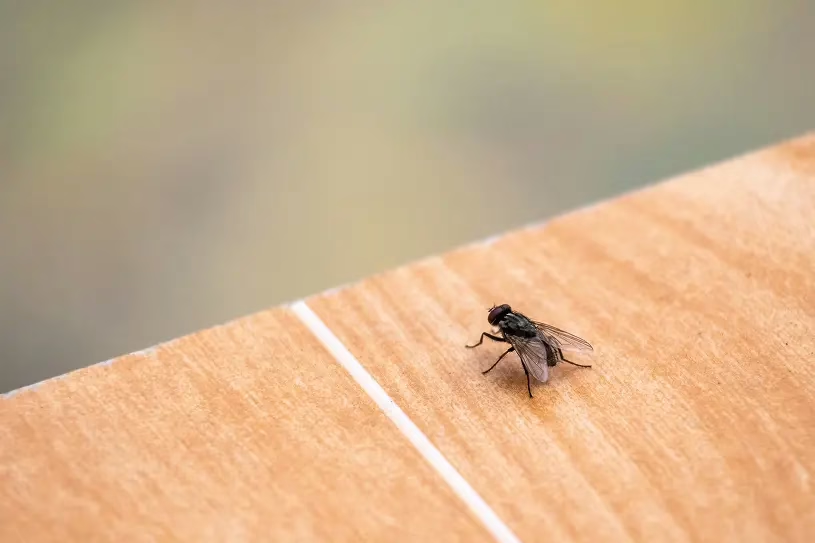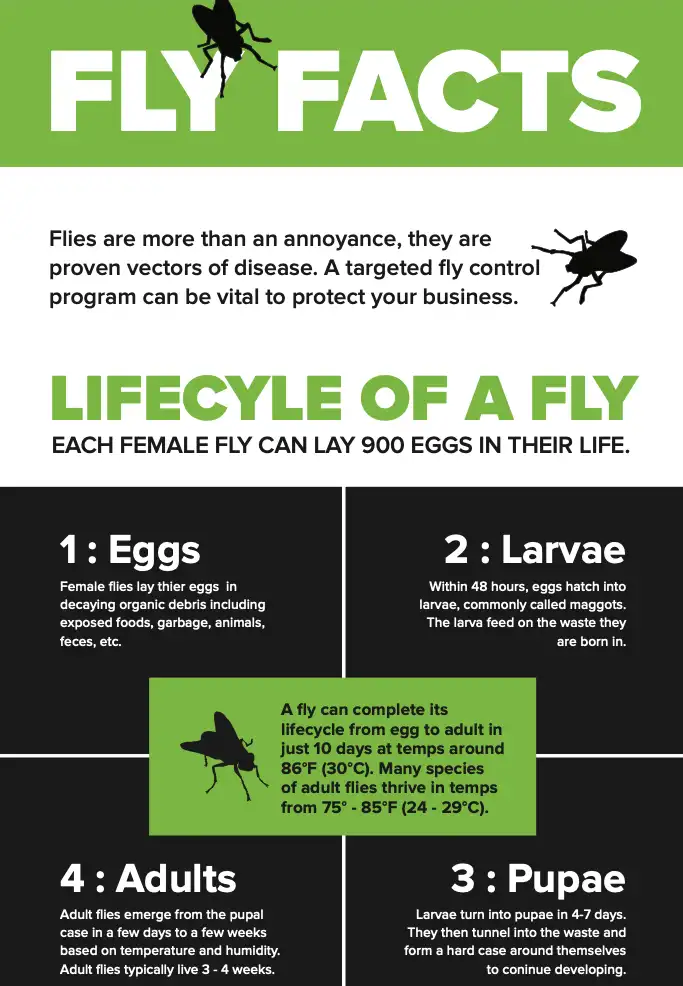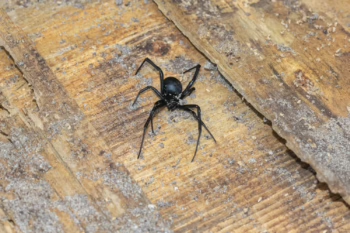
Flies are more than just a nuisance! They can spread dangerous bacteria like Salmonella and E. coli. These pests pose serious health risks and contamination issues for businesses. Their presence can damage your reputation and lead to failed health inspections. Under the right conditions, even a small infestation can rapidly grow. Basic solutions like sprays or swatters typically fall short because they don’t eliminate the root cause.
Professional fly exterminators, such as those from Bug Out, work to eliminate flies by addressing all phases of their development.

Download Fly Facts Infographic
Flies are more than an annoyance, they are proven vectors of disease. A targeted fly control program can be vital to protect your business. Learn more about flies with these facts.
Download Your CopyThe Stages of the Fly Lifecycle
Managing a fly infestation isn’t easy because flies reproduce rapidly. One female can lay up to 900 eggs, which may hatch into maggots within 48 hours. These larvae thrive on decaying organic material and can develop into adults in just 10 days under the right conditions. Let’s break down each stage of the fly lifecycle:
- Eggs: Female flies deposit their eggs on decaying organic material such as dead animals, waste, spoiled food, or garbage. Over her lifetime, a single fly may lay as many as 900 eggs.
- Larvae (Maggots): In roughly 48 hours, these eggs hatch into larvae, better known as maggots, which feed on the decomposing matter where they were laid.
- Pupae: After feeding for about 4 to 7 days, maggots transition into the pupal stage. They burrow into the surface of their food source and form a hardened shell while undergoing transformation.
- Adults: The adult fly emerges from its pupal case within several days to a few weeks, depending on factors like temperature and moisture. Once mature, adult flies typically live for 3 to 4 weeks.
Flies mature rapidly in warm weather, becoming adults in just 10 days at around 86°F (30°C). They thrive in temperatures between 75°F and 85°F (24°C–29°C), and without addressing the root cause, their populations can sur.
Understanding the Feeding Habits of Flies
Flies are incredibly versatile when it comes to feeding. Their ability to eat both fresh and rotting materials makes them well-suited to thrive in a variety of environments, which contributes to their persistence. Knowing what draws flies in is key to controlling them. Their diet includes a wide range of food sources, such as:
- Plants: Flies commonly land on vegetation, where they feed on the moisture and juices found in leaves and flowers.
- Nectar: The sugary nectar produced by flowers draws flies in search of a quick, energy-dense food source.
- Feces & Sewage: Animal waste and sewage serve as both feeding grounds and breeding sites for flies.
- Decomposing Animals: The decaying remains of animals supply essential nutrients that support flies throughout their development.
- Human Food: Exposed food in kitchens, restaurants, and marketplaces often attracts flies looking for an easy meal.
- Sugary Substances: Sweet liquids such as syrup, soda, and fruit juice are especially appealing to flies.
- Garbage: Household and commercial trash bins offer flies a reliable mix of food scraps and suitable places to lay eggs.
- Decaying Matter: Organic materials in various stages of decay are ideal environments for flies to feed and reproduce.
How Flies Digest Food
Adult flies can’t chew their food due to a unique mouthpart called a proboscis, which functions like a straw to sip liquids. To eat solid food, they spit out enzyme-rich saliva that breaks it down into a liquid form. This allows them to easily absorb nutrients. Their feeding method makes them especially drawn to sugary and rotting materials that dissolve quickly.
Understanding the Risks of Flies
Flies pick up dangerous bacteria when they land on contaminated surfaces and then transfer these germs to areas like kitchens and dining spaces. Since they travel between filthy and clean places, they easily spread pathogens. This can result in foodborne illnesses that cause symptoms like nausea, diarrhea, cramps, and fever. Keeping flies out is the best way to lower this risk.
Preventing Flies from Entering Your Facility
One of the best ways to control flies is by keeping them from entering your facility. They often sneak in through open doors, windows, and tiny cracks around the building. Maintaining good sanitation is essential for minimizing fly issues. Here are some helpful tips to begin with:
- Close Entrances: Ensure doors and windows remain closed when not in use. For openings that need to stay open, install screens or air curtains to block flies.
- Maintain Dumpsters: Schedule regular dumpster emptying and cleaning. Replace dumpsters if necessary and frequently wash down the areas where dumpsters sit.
- Manage Trash: Empty garbage cans both indoors and outdoors every day. Securely seal trash bags before placing them in outdoor dumpsters.
- Seal Gaps: Work with your pest control technician to identify and seal gaps around doors, windows, pipes, and other potential fly entry points.
- Use Light Traps: Place insect light traps in locations with heavy fly activity. Consult a pest control expert for optimal positioning.
- Outdoor Baiting: Coordinate with your pest control provider to implement an outdoor baiting program that helps lower fly populations near your facility.
What is Professional Fly Exclusion?
Professional fly exclusion is a proven way to stop flies from entering your property. Our pest control experts use advanced methods to seal possible entry points, creating a strong barrier. Tools such as fly screens, air curtains, and door sweeps offer dependable protection. These measures not only keep flies out but also improve overall facility hygiene.
We also locate and close openings or cracks on the outside walls that might serve as fly entry points.
Choose Bug Out for Professional Pest Management
Controlling flies requires consistent attention and maintenance. Trying to manage the problem on your own can take up valuable time and may not be effective, pulling you away from your core business operations. Bug Out designs customized fly control plans for your business and offers ongoing support to keep your facility free of flies.
Our skilled technicians find and remove breeding sites, use exclusion techniques, and apply targeted treatments to eliminate adult flies. We focus on uncovering hidden breeding areas to prevent infestations before they develop. Protect your North Carolina facility from fly threats with our trusted control solutions.
Contact Bug Out today to schedule a fly control consultation with one of our experienced technicians.





